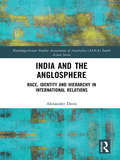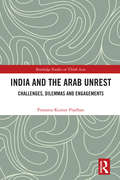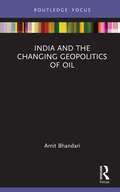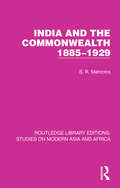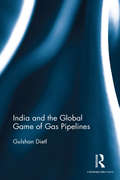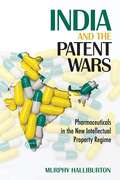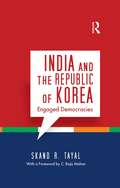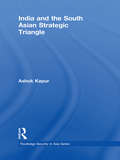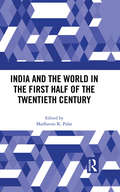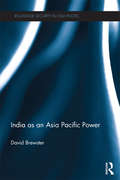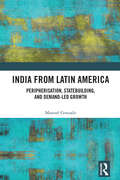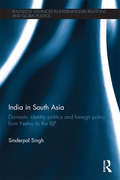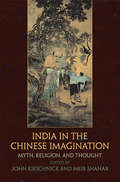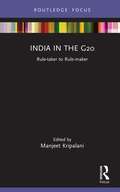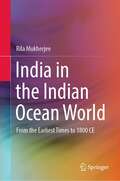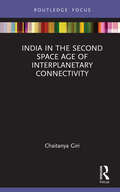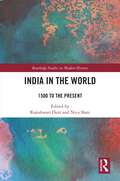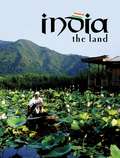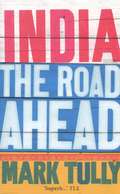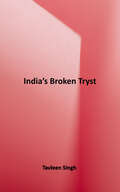- Table View
- List View
India and the Anglosphere: Race, Identity and Hierarchy in International Relations (Routledge/Asian Studies Association of Australia (ASAA) South Asian Series)
by Alexander E. DavisIndia has become known in the US, the UK, Canada and Australia as ‘the world’s largest democracy’, a ‘natural ally’, the ‘democratic counterweight’ to China and a trading partner of ‘massive economic potential’. This new foreign policy orthodoxy assumes that India will join with these four states and act just as any other democracy would. A set of political and think tank elites has emerged which seek to advance the cause of a culturally superior, if ill-defined, ‘Anglosphere’. Building on postcolonial and constructivist approaches to international relations, this book argues that the same Eurocentric assumptions about India pervade the foreign policies of the Anglosphere states, international relations theory and the idea of the Anglosphere. The assertion of a shared cultural superiority has long guided the foreign policies of the US, the UK, Canada and Australia, and this has been central to these states’ relationships with postcolonial India. This book details these difficulties through historical and contemporary case studies, which reveal the impossibility of drawing India into Anglosphere-type relationships. At the centre of India-Anglosphere relations, then, is not a shared resonance over liberal ideals, but a postcolonial clash over race, identity and hierarchy. A valuable contribution to the much-needed scholarly quest to follow a critical lens of inquiry into international relations, this book will be of interest to academics and advanced students in international relations, Indian foreign policy, Asian studies, and those interested in the ‘Anglosphere’ as a concept in international affairs.
India and the Arab Unrest: Challenges, Dilemmas and Engagements (Routledge Studies on Think Asia)
by Prasanta Kumar PradhanThis book is a study of India’s political, diplomatic and security challenges caused by the changing geopolitical and security dynamics in the Middle East and North Africa (MENA) region. Like many other countries, India has been deeply affected by the unrest in the Arab world. As India has several long-term economic, political and security stakes in the region, it has adopted extreme caution in its responses towards the developments in the MENA region since the beginning of the Arab unrest. This book examines India’s policy of non-intervention and opposition to military intervention in the internal and regional affairs of the MENA region. In response to the ongoing conflict, India has engaged with several regional organisations and multilateral forums to work together and find political solutions to the regional conflicts. The book also examines new developments, such as the rise of the Islamic State, and the new security challenges this has introduced. Despite the regional turbulences, the momentum of India’s engagements with the countries of the region has been maintained and India has been building mutually beneficial partnerships in diverse fields. In this context, the book examines the response, approach and the policies India has adopted to protect and promote its interests during the last ten years of unrest. This book will be of interest to researchers, students and policy makers in the fields of international relations, India’s foreign policy, Asian studies, international studies, comparative studies and area studies of the Middle East and South Asia.
India and the Changing Geopolitics of Oil (The Gateway House Guide to India in the 2020s)
by Amit BhandariThe global energy scenario has transformed in the past 20 years. Oil demand, earlier driven by the West, is now shifting to the East, more specifically to Asia. New oil supplies from North America have challenged the hegemony of the traditional oil exporters from West Asia and Africa. India, once a marginal player in the world oil market, is now a valued customer providing demand security for oil exporters. This book systematically examines India’s oil and gas trade, which makes it the world’s third largest importer of oil after China and the US. It explores the changing patterns of oil demand and supply, and the growing market for natural gas, renewable energy, biofuel, and alternative sources of energy. Further, the volume discusses a range of issues that affect India’s position in the global energy econom,y such as The geographic shifts in energy production and trade; international relations and economic sanctions that affect the oil trade; India’s quest for energy security; and contest with China for oil assets; Building new partnerships, and investing in stable, oil-rich countries like the US and Canada, while keeping up existing energy relations with Saudi Arabia, the UAE and Kuwait; Using market mechanisms to ensure energy security. Topical and comprehensive, this book in The Gateway House Guide to India in the 2020s series will be useful for scholars and researchers of international relations, geopolitics, foreign policy, security and strategic studies, energy studies, West Asia studies, South Asian studies, and international trade. It will also be of interest to policymakers, diplomats, career bureaucrats, and professionals working with think tanks, academia and multilateral agencies, media agencies, and businesses.
India and the Changing World Order
by Shveta DhaliwalThis book brings together new perspectives on India’s foreign policy in the light of a constantly shifting world order. From India’s relations in its immediate neighborhood to its China policy, from India-US relations under Biden to Quad, from Grand Strategy to peacekeeping, this book brings to the fore the shifting terrains of global politics and India’s significant place in it. The chapters in the volume: Critically examine changing preoccupations of India’s foreign policy and its geopolitical interests, including its Act East Policy; Include comprehensive inputs on India’s China policy and relations with Japan; Explore India’s relations with the USA, the Middle-East, Afghanistan, and Central Asia; Discuss at length India’s nuclear, energy, and foreign investment policies; Analyze India’s positioning on the emergence of the Indo-Pacific discourse. This volume will be of great interest to scholars and researchers of political science and international relations. It will also be of use to foreign policy and diplomacy practitioners, career bureaucrats and government think tanks.
India and the Commonwealth 1885–1929 (Studies on Modern Asia and Africa)
by S. R. MehrotraThe story of the transformation of the old British Empire into the modern Commonwealth had often been told from the point of view of Great Britain and the ‘white dominions’. No attempt had so far been made to describe the decisive role of India in the shaping of the multi-racial Commonwealth of today. Originally published in 1965, the main theme of this work by an Indian author is the growth of the idea of Commonwealth in India from 1885, the year in which the Indian National Congress was organized, to 1929, when Congress declared ‘complete independence’ to be its goal. What did the British Empire mean to early Indian nationalists? How did the ideal of self-government of India on the Dominion model grow? What was India’s continued association with the Commonwealth valued in India and in Britain? Answers to these and similar questions are attempted in this book. Despite its great importance, the role of India in the Commonwealth in the nineteenth and early twentieth centuries had received little attention from scholars. Dr Mehrotra’s clear, incisive, informed and balanced study was therefore the more welcome, not only for its source, but because it lent a new dimension to our understanding of India’s part in defining and enlarging the idea of Commonwealth. It is an important contribution to Commonwealth and to modern Indian history.
India and the Contemporary World-II class 10 - NCERT - 23 (History)
by National Council of Educational Research and Training"India and the Contemporary World - II" by NCERT is a comprehensive textbook that delves into India's history from the 18th century to the mid-20th century, focusing on key events, socio-political changes, and their global impact. It explores the advent of modernity, colonialism, and nationalism, providing an insightful analysis of India's struggle for independence. The book navigates through significant historical periods, such as the rise of nationalism, the Indian National Movement, and the impact of World War I and II on India. It delves into the social and cultural dynamics, examining factors like caste, class, and gender, and their roles in shaping India's history during this time. Through a balanced and nuanced approach, the book not only presents the historical facts but also encourages critical thinking by highlighting diverse perspectives and their implications in shaping the contemporary world. It offers a comprehensive overview of India's journey from colonial subjugation to the emergence of an independent nation, contextualizing its place in the global socio-political landscape.
India and the Global Game of Gas Pipelines
by Gulshan DietlGas pipelines constitute an important, yet unexplored, aspect of strategic geography. As one of the fastest growing economies in the world, India’s need for energy is paramount. Though surrounded by gas-rich regions – Myanmar and Bangladesh to the east, the Gulf to the west and Central Asia to the north – India does not have a single gas pipeline coming in, going out or traversing through its territory to date. This book highlights the global competition over gas pipelines and its implications for India’s energy security in a comprehensive manner. The author leads us through a labyrinthine world comprising numerous actors – the states, energy firms, scientists, engineers, investors and bankers – engaged in competition over these pipelines leading to a continuous game of checkmating rivals, instigating conflicts, causing damage and destruction and threatening military action to persuade or dissuade states from joining specific projects. Pulsating, rigorous, grounded in hard facts and solid research, this book will be indispensable for scholars and researchers of international relations, strategic affairs, defence studies and politics, as well as think tanks, government agencies and the informed general reader.
India and the Islamic Heartlands
by Sood Gagan D. S."Based on the chance survival of a remarkable cache of documents, India and the Islamic Heartlands recaptures a vanished and forgotten world from the eighteenth century spanning much of today's Middle East and South Asia. Gagan Sood focuses on ordinary people--traders, pilgrims, bankers, clerics, brokers, scribes, among others--who were engaged in activities marked by large distances and long silences. By elucidating their everyday lives in a range of settings, from the family household to the polity at large, Sood pieces together the connective tissue of a world that lay beyond the sovereign purview. Recapturing this obscured and neglected world helps us better understand the region during a pivotal moment in its history, and offers new answers to old questions concerning early modern Eurasia and its transition to colonialism"--
India and the Patent Wars: Pharmaceuticals in the New Intellectual Property Regime (The Culture and Politics of Health Care Work)
by Murphy HalliburtonIndia and the Patent Wars contributes to an international debate over the costs of medicine and restrictions on access under stringent patent laws showing how activists and drug companies in low-income countries seize agency and exert influence over these processes. Murphy Halliburton contributes to analyses of globalization within the fields of anthropology, sociology, law, and public health by drawing on interviews and ethnographic work with pharmaceutical producers in India and the United States.India has been at the center of emerging controversies around patent rights related to pharmaceutical production and local medical knowledge. Halliburton shows that Big Pharma is not all-powerful, and that local activists and practitioners of ayurveda, India’s largest indigenous medical system, have been able to undermine the aspirations of multinational companies and the WTO. Halliburton traces how key drug prices have gone down, not up, in low-income countries under the new patent regime through partnerships between US- and India-based companies, but warns us to be aware of access to essential medicines in low- and middle-income countries going forward.
India and the Republic of Korea: Engaged Democracies
by Skand R. TayalExamining the underlying logic of the strategic and economic partnership between the Republic of Korea and India, this book is the first detailed study of the numerous facets — cultural, economic, people-to-people, and strategic — of blossoming relations between two major Asian democracies. This comprehensive survey documents the interaction between the two governments, relying on facts and hitherto unpublished original records provided by India’s Ministry of External Affairs; offers an illuminating account of India’s active role as a neutral party in the post-Second World War events of the Korean War and the division of the Korean Peninsula; and provides a vision of the future direction of India–Korea relations. The author also shares candid observations of Korean society and its people during his service as Ambassador of India in Seoul. The work will be useful to policy makers as well as students of politics and international relations, strategic studies, economics, and contemporary world history.
India and the South Asian Strategic Triangle (Routledge Security in Asia Series)
by Ashok KapurThis book traces the triangular strategic relationship of India, Pakistan and China over the second half of the twentieth century, and shows how two enmities – Sino-Indian and Indo-Pakistani – and one friendship – Sino-Pakistani – defined the distribution of power and the patterns of relationships in a major centre of gravity of international conflict and international change. The three powers are tied to each other and their actions reflect their view of strategic and cultural problems and geopolitics in a volatile area. The book considers internal debates within the three countries; zones of conflict, including northeast and northwest south Asia, the Himalayas and the Indian Ocean; and the impact of developments in nuclear weapons and missile technology. It examines the destructive consequences of China’s harsh methods in Tibet, of China’s encouragement of military rather than democratic regimes in Pakistan, and of China’s delay in dealing with the border disputes with India. Ashok Kapur shows how the Nehru-Chou rhetoric about "peaceful co-existence" affected the relationship, and how the dynamics of the relationship have changed significantly in recent years as a range of new factors - including India’s increasing closeness to the United States - have moved the relationship into a new phase.
India and the World in the First Half of the Twentieth Century
by Madhavan K. PalatThis book examines how India was placed and placed itself in the world during the first half of the 20th century in a period of global turmoil and set against the subcontinental contest for independence. In situating India in the world, it looks not just at current foreign policy studies, but also at geopolitics, World War experiences, theoretical and strategic approaches, early foreign policy institutional transitions and the role of Indian civil and foreign diplomatic services. The work explores history and theory with a focus on cosmopolitanism beyond nationalism. The use of extensive sources from archives in UK and Russia — especially in different languages, mainly German and Russian — lends this volume an edge over most other works. The book will be useful to professional academics, historians including military historians, security specialists, literary specialists, foreign policy experts, journalists and the general reader interested in international issues.
India as an Asia Pacific Power (Routledge Security in Asia Pacific Series)
by David BrewsterThe emergence of India as a regional and potentially global power is forcing us to rethink our mental map of the Asia Pacific. We are only just beginning to discern how India may alter the global economic landscape. How will the rise of India change the strategic landscape of Asia and beyond? This book provides a comprehensive assessment of India's international relations in the Asia Pacific, a region which has not traditionally been understood to include India. It examines India’s strategic thinking about the Asia Pacific, its relationships with China and the United States, and India's increasingly close security ties with other major countries in the region. It considers the consequences of India’s rise on the Asia Pacific strategic order and asks whether India is likely to join the ranks of the major powers of the Asia Pacific in coming years.
India from Latin America: Peripherization, Statebuilding, and Demand-Led Growth
by Manuel GonzaloThis book studies the economic history of India and traces the Indian path of development from a Latin American framework and perspective. Despite sharing many historical and geological similarities, dialogue between the young democracies of Latin America and the Indian subcontinent is still extremely scarce. The volume builds a common research agenda for the economic development of the Global South. It offers Latin American insights and highlights novelties and commonalities the region shares with India’s economic development. It pays special attention to the (geo)political, technological, financial, and institutional aspects related to the specific geographical and demographical features of the Indian subcontinent. A step towards strengthening the dialogue on economic development in the Global South, this book will be of interest to scholars and researchers of heterodox economics, Indian economy, comparative economics, macroeconomics, political economy, economic history, development studies, Latin American studies, and South Asian studies.
India in South Asia: Domestic Identity Politics and Foreign Policy from Nehru to the BJP (Routledge Advances in International Relations and Global Politics)
by Sinderpal SinghSouth Asia is one of the most volatile regions of the world, and India’s complex democratic political system impinges on its relations with its South Asian neighbours. Focusing on this relationship, this book explores the extent to which domestic politics affect a country’s foreign policy. The book argues that particular continuities and disjunctures in Indian foreign policy are linked to the way in which Indian elites articulated Indian identity in response to the needs of domestic politics. The manner in which these state elites conceive India’s region and regional role depends on their need to stay in tune with domestic identity politics. Such exigencies have important implications for Indian foreign policy in South Asia. Analysing India’s foreign policy through the lens of competing domestic visions at three different historical eras in India’s independent history, the book provides a framework for studying India’s developing nationhood on the basis of these idea(s) of ‘India’. This approach allows for a deeper and a more nuanced interpretation of the motives for India’s foreign policy choices than the traditional realist or neo-liberal framework, and provides a useful contribution to South Asian Studies, Politics and International Studies.
India in the Chinese Imagination: Myth, Religion, and Thought (Encounters with Asia)
by John Kieschnick Meir ShaharIndia and China dominate the Asian continent but are separated by formidable geographic barriers and language differences. For many centuries, most of the information that passed between the two lands came through Silk Route intermediaries in lieu of first-person encounters—leaving considerable room for invention. From their introduction to Indian culture in the first centuries C.E., Chinese thinkers, writers, artists, and architects imitated India within their own borders, giving Indian images and ideas new forms and adapting them to their own culture. Yet India's impact on China has not been greatly researched or well understood.India in the Chinese Imagination takes a new look at the ways the Chinese embedded India in diverse artifacts of Chinese religious, cultural, artistic, and material life in the premodern era. Leading Asian studies scholars explore the place of Indian myths and storytelling in Chinese literature, how Chinese authors integrated Indian history into their conception of the political and religious past, and the philosophical relationships between Indian Buddhism, Chinese Buddhism, and Daoism. This multifaceted volume, illustrated with over a dozen works of art, reveals the depth and subtlety of the encounter between India and China, shedding light on what it means to imagine another culture—and why it matters.Contributors: Stephen R. Bokenkamp, Bernard Faure, John Kieschnick, Victor H. Mair, John R. McRae, Christine Mollier, Meir Shahar, Robert H. Sharf, Nobuyoshi Yamabe, Ye Derong, Shi Zhiru.
India in the G20: Rule-taker to Rule-maker (The Gateway House Guide to India in the 2020s)
by Manjeet KripalaniThis book analyses the importance of the G20 to India, its role so far, and how it can leverage its presidency year to be an influential author of new global rules. In 2023, India will be the President of the G20 Summit, the world’s most influential multilateral economic forum. For countries like India, the G20 is a unique global institution, where developed and developing countries have equal stature. This creates opportunities to showcase their global political, economic and intellectual leadership, have a significant impact on the global economic governance agenda and make it more inclusive. This volume discusses how the Presidency year gives India the opportunity to ‘… hold the pen, write the rules’ and lead the G20 year intellectually, financially, managerially and administratively. It provides a ringside view of India’s path to the G20 Presidency and examines issues such as the core agenda of the G20; explains the significance of forums like T20, B20, and their proliferations; India’s journey as a marginal player in the G20 to its current status; issue of dedicated leadership and management; and India’s Agenda for 2023. Topical, timely, important and lucidly written, this book in The Gateway House Guide to India in the 2020s series will be key reading for scholars and researchers of economics, multilaterals, global governance, strategic studies, defence studies, SAARC, UN Studies, foreign policy, international relations, international economics and international trade, as well as interest to policymakers, diplomats, career bureaucrats, and professionals working with think tanks, academia and multilateral agencies, and business.
India in the Indian Ocean World: From the Earliest Times to 1800 CE
by Rila MukherjeeThe book integrates the latest scholarly literature on the entire Indian Ocean region, from East Africa to China. Issues such as India's history, India’s changing status in the region, and India's cross-cultural networking over a long period are explored in this book. It is organized in specific themes in thirteen chapters. It incorporates a wealth of research on India’s strategic significance in the Indian Ocean arena throughout history. It enriches the reader's understanding of the emergence of the Indian Ocean basin as a global arena for cross-cultural networking and nation-building. It discusses issues of trade and commerce, the circulation of ideas, peoples and objects, and social and religious themes, focusing on Hinduism, Buddhism, and Islam. The book provides a refreshingly different survey of India’s connected history in the Indian Ocean region starting from the archaeological record and ending with the coming of empire. The author’s unique experience, combined with an engaging writing style, makes the book highly readable. The book contributes to the field of global history and is of great interest to researchers, policymakers, teachers, and students across the fields of political, cultural, and economic history and strategic studies.
India in the Second Space Age of Interplanetary Connectivity (The Gateway House Guide to India in the 2020s)
by Chaitanya GiriThis volume discusses the emergence of space exploration as a new pivot of the global space economy in the decade of 2020s. Space exploration and human spaceflight will soon become vital strategic initiatives in the imminent second space age, evolving from scientific pursuits to mega-economic projects. As the scope of international cooperation in space forays into soft science diplomacy, the second space age opens opportunities for India to mount its space program as an ambitious yet conscientious, proficient, and cordial player in the global space economy. This book, — Explores imminent trends in space exploration and interplanetary connectivity plans, their returns to the global economy of the future, and impact on the global astropolitical order; — Analyses the techno-economic significance of India’s space exploration by reviewing the legal, ethical and philosophical challenges; the limits of global space exploration policies; and the economic lacunae for the astropolitical gains; — Examines the transformational trio of Chandrayaan, Mangalyaan and Gaganyaan; dawn of the second space age; interplanetary connectivity projects; besides discussing the viability of humans becoming an interplanetary species. Part of The Gateway House Guide to India in the 2020s series, this topical volume will be useful for scholars and researchers of international relations, geopolitics, foreign policy, space policy, South Asian studies, strategic studies, and international trade.
India in the World: 1500 to the Present (Routledge Studies in Modern History)
by Nico Slate Rajeshwari DuttIf we look back at world history in the past five hundred years, it is evident that Indian ideas, peoples, and goods helped drive world connections. From the quest to reach the Indies that drove Iberian rulers to fund costly expeditions that ultimately connected the Old World with the Americas to Gandhi’s creed of non-violence that created transnational resistance movements, India has been crucial to world history. In what ways have the movement of goods, people, and ideas from India served to connect the world? Conversely, how has India’s global history shaped the many boundaries and inequalities that have divided the world despite—and at times because of—the transnational connections often lumped together under the aegis of globalization? Through its emphasis on both linkages and boundaries, India in the World examines the range of connections between India and the world in a truly global perspective.
India of My Dreams
by M. K. GandhiIt is a happy idea to place before the world and the country at the present moment when we are entering upon a new era a picture of the India of Mahatma Gandhi’s dreams. The freedom which we have won is throwing upon us the responsibilities of making or marring the future of India. It is in no small measure the achievement of Mahatma Gandhi’s leadership. The matchless weapon of truth and non-violence which he has used is needed by the world to cure it of many of its ills. In our hour of victory and rejoicings we cannot afford to ignore either the leader who has led us or the undying principles which have inspired him. Freedom is only the means to a greater and nobler end, and the achievement of India of Mahatma Gandhi’s dreams will be the fitting consummation of all that he has worked for and stands for. A book, which places before the reader not only those basic and fundamental principles, but also indicates how we can help to fulfil them through our freedom by establishing a polity and social life, and through the instrumentality of a constitution and the dedication of the human material which this vast country will now throw up to work without any external fetters or internal inhibitions. — Rajendra Prasad
India the Land (Lands, Peoples, and Cultures)
by Bobbie KalmanUpdated facts and statistics highlight this new second revised edition of India the Land. Spectacular photographs feature India's varied geography from snow-covered mountaintops to tropical rainforests. Learn about India's major cities, its disputed borders, foreign influences, and current challenges
India the Road Ahead
by Mark TullyFull of fascinating stories of real people at a time of great change, it will be of interest to economists, business people, diplomats, politicians, as well as to those who love to travel and who take an interest in the rapid growth of one of the world's largest countries, and what this means to us in the West.
India's Broken Tryst
by Tavleen SinghSeventy years after Nehru’s beautiful midnight speech – ‘Long years ago we made a tryst with destiny…’ – in Indian cities and villages millions survive on less than the bare minimum. Children are not in classrooms, women have nowhere safe to relieve themselves, and jobless men lie around in a daze. In cities, where initiative should flourish, a merciless state looms large over every common endeavour. The civilization that was India, that grand culture, has not found utterance again. Long years after freedom from the British, why do we remain suppressed? In India’s Broken Tryst, bestselling author and popular political columnist Tavleen Singh chronicles the damage done. Here is the story of Surekha, who lives on the pavements of Mumbai’s landmark Marine Drive with memories of crushing hunger. Of Ali, the idli seller who is forced out of his honest livelihood by cops and corporators. Of Sahib and Sardar, little boys torn from their mother on the criminal charge of begging. Of those nameless servants who do not have access to toilets even as they service the luxury apartments where Singh lives. From the very poor to the very rich, Tavleen Singh catalogues in bold, eviscerating detail the systematic unmaking of our sense of destiny. Can an Indian dream stretch beyond food and water, literacy, toilets, and in some cases just a document of identification? If not, what destiny?
